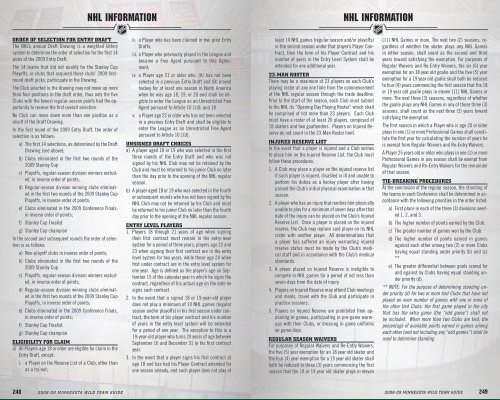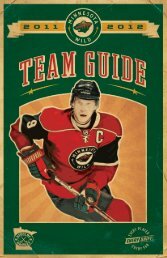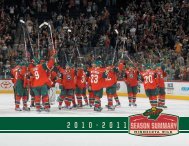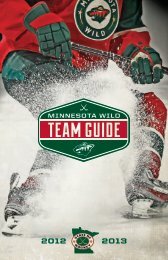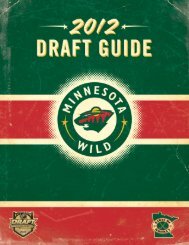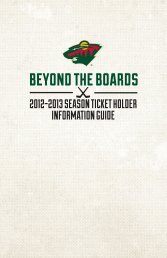You also want an ePaper? Increase the reach of your titles
YUMPU automatically turns print PDFs into web optimized ePapers that Google loves.
32 Backstrom25 Belanger47 Bergeron24 Boogaard96 Bouchard15 brunette8 burns26 foster10 Gaborik29 Harding5 johnsson9 koivu20 miettinen11 nolan2 reitz55 schultz51 Sheppard41 skoula19 Veilleux12 Weller3 ZidlickyOrder of Selection for Entry DraftThe NHL’s annual Draft Drawing is a weighted lotterysystem <strong>to</strong> determine the order of selection for the first 14picks of the 2009 Entry Draft.The 14 teams that did not qualify for the Stanley CupPlayoffs, or clubs that acquired those clubs’ 2009 firstrounddraft picks, participate in the Drawing.The Club selected in the drawing may not move up morethan four positions in the draft order, thus only the fiveClubs with the fewest regular-season points had the opportunity<strong>to</strong> receive the first overall selection.No Club can move down more than one position as aresult of the Draft Drawing.In the first round of the 2009 Entry Draft, the order ofselection is as follows:a) The first 14 selections, as determined by the DraftDrawing (see above);b) Clubs eliminated in the first two rounds of the2009 Stanley Cupc) Playoffs, regular-season division winners excluded,in inverse order of points;d) Regular-season division winning clubs eliminatedin the first two rounds of the 2009 Stanley CupPlayoffs, in inverse order of points;e) Clubs eliminated in the 2009 Conference Finals,in inverse order of points;f) Stanley Cup Finalistg) Stanley Cup championIn the second and subsequent rounds the order of selectionis as follows:a) Non-playoff clubs in inverse order of points;b) Clubs eliminated in the first two rounds of the2009 Stanley Cupc) Playoffs, regular-season division winners excluded,in inverse order of points;d) Regular-season division winning clubs eliminatedin the first two rounds of the 2009 Stanley CupPlayoffs, in inverse order of points;e) Clubs eliminated in the 2009 Conference Finals,in inverse order of points;f) Stanley Cup Finalistg) Stanley Cup championEligibility for Claima) All Players age 18 or older are eligible for claim in theEntry Draft, except:i. a Player on the Reserve List of a Club, other thanas a try-out;NHL Informationii. a Player who has been claimed in two prior EntryDrafts;iii. a Player who previously played in the League andbecame a Free Agent pursuant <strong>to</strong> this Agreement;iv. a Player age 21 or older who: (A) has not beenselected in a previous Entry Draft and (B) playedhockey for at least one season in North Americawhen he was age 18, 19, or 20 and shall be eligible<strong>to</strong> enter the League as an Unrestricted FreeAgent pursuant <strong>to</strong> Article 10.1(d); and 18v. a Player age 22 or older who has not been selectedin a previous Entry Draft and shall be eligible <strong>to</strong>enter the League as an Unrestricted Free Agentpursuant <strong>to</strong> Article 10.1(d).Unsigned Draft Choicesa) A player aged 18 or 19 who was selected in the firstthree rounds of the Entry Draft and who was notsigned by his NHL Club may not be retained by theClub and must be returned <strong>to</strong> his junior Club no laterthan the day prior <strong>to</strong> the opening of the NHL regularseason.b) A player aged 18 or 19 who was selected in the fourthor subsequent rounds who has not been signed by hisNHL Club may not be retained by his Club and mustbe returned <strong>to</strong> his junior Club no later than the fourthday prior <strong>to</strong> the opening of the NHL regular season.Entry Level Players1. Players 18 through 21 years of age when signingtheir first contract must remain in the entry-levelsystem for a period of three years; players age 22 and23 when signing their first contract are in the entrylevel system for two years; while those age 24 whenfirst under contract are in the entry level system forone year. Age is defined as the player’s age on September15 of the calendar year in which he signs thecontract, regardless of his actual age on the date hesigns such contract.2. In the event that a signed 18 or 19-year-old playerdoes not play a minimum of 10 NHL games (regularseason and/or playoffs) in his first season under contract,the term of his player contract and his numberof years in the entry level system will be extendedfor a period of one year. The exception <strong>to</strong> this is a19-year-old player who turns 20 years of age betweenSeptember 16 and December 31 in his first contractyear.3. In the event that a player signs his first contract atage 18 and has had his Player Contract extended forone season already, and such player does not play atleast 10 NHL games (regular season and/or playoffs)in the second season under that player’s Player Contract,then the term of his Player Contract and hisnumber of years in the Entry Level System shall beextended for one additional year.23-Man RosterT<strong>here</strong> may be a maximum of 23 players on each Club’splaying roster at any one time from the commencemen<strong>to</strong>f the NHL regular season through the trade deadline.Prior <strong>to</strong> the start of the season, each Club must submit<strong>to</strong> the NHL its “Opening Day Playing Roster” which shallbe comprised of not more than 23 players. Each Clubmust have a roster of at least 20 players, composed of18 skaters and two goaltenders. Players on Injured Reservedo not count in the 23-Man Roster limit.Injured Reserve ListIn the event that a player is injured and a Club wishes<strong>to</strong> place him on the Injured Reserve List, the Club mustfollow these procedures.1. A Club may place a player on the injured reserve listif such player is injured, disabled or ill and unable <strong>to</strong>perform his duties as a hockey player after havingpassed the Club’s initial physical examination in thatseason.2. A player who has an injury that renders him physicallyunable <strong>to</strong> play for a minimum of seven days after thatdate of the injury can be placed on the Club’s InjuredReserve List. Once a player is placed on the injuredreserve, the Club may replace said player on its NHLroster with another player. All determinations thata player has suffered an injury warranting injuredreserve status must be made by the Club’s medicalstaff and in accordance with the Club’s medicalstandards.3. A player placed on Injured Reserve is ineligible <strong>to</strong>compete in NHL games for a period of not less thanseven days from the date of injury.4. Players on Injured Reserve may attend Club meetingsand meals, travel with the Club and participate inpractice sessions.5. Players on Injured Reserve are prohibited from appearingin games, participating in pre-game warmupswith their Clubs, or dressing in game uniformson game days.Regular Season WaiversFor purposes of Regular Waivers and Re-Entry Waivers,the five (5) year exemption for an 18 year old skater andthe four (4) year exemption for a 19 year old skater shallboth be reduced <strong>to</strong> three (3) years commencing the firstseason that the 18 or 19 year old skater plays in elevenNHL Information(11) NHL Games or more. The next two (2) seasons, regardlessof whether the skater plays any NHL Gamesin either season, shall count as the second and thirdyears <strong>to</strong>ward satisfying the exemption. For purposes ofRegular Waivers and Re-Entry Waivers, the six (6) yearexemption for an 18 year old goalie and the five (5) yearexemption for a 19 year old goalie shall both be reduced<strong>to</strong> four (4) years commencing the first season that the 18or 19 year old goalie plays in eleven (11) NHL Games ormore. The next three (3) seasons, regardless of whetherthe goalie plays any NHL Games in any of those three (3)seasons, shall count as the next three (3) years <strong>to</strong>wardsatisfying the exemption.The first season in which a Player who is age 20 or olderplays in one (1) or more Professional Games shall constitutethe first year for calculating the number of years heis exempt from Regular Waivers and Re-Entry Waivers.A Player 25 years old or older who plays in one (1) or moreProfessional Games in any season shall be exempt fromRegular Waivers and Re-Entry Waivers for the remainderof that season.Tie-Breaking ProceduresAt the conclusion of the regular season, the standing ofthe teams in each Conference shall be determined in accordancewith the following priorities in the order listed:a) First place in each of the three (3) divisions seeded1, 2, and 3.b) The higher number of points earned by the Club.c) The greater number of games won by the Club.d) The higher number of points earned in gamesagainst each other among two (2) or more Clubshaving equal standing under priority (b) and (c)**e) The greater differential between goals scored forand against by Clubs having equal standing underpriority (d).** NOTE: For the purpose of determining standing underpriority (d) for two or more tied Clubs that have notplayed an even number of games with one or more ofthe other tied Clubs, the first game played in the citythat has the extra game (the “odd game”) shall notbe included. When more than two Clubs are tied, thepercentage of available points earned in games amongeach other (and not including any “odd games”) shall beused <strong>to</strong> determine standing.248 2008-09 MINNESOTA WILD TEAM GUIDE 2008-09 MINNESOTA WILD TEAM GUIDE 249Table of contents Hockey Operations <strong>Wild</strong> THings The Players Team His<strong>to</strong>ry Team Records Playoff His<strong>to</strong>ry The NHL


